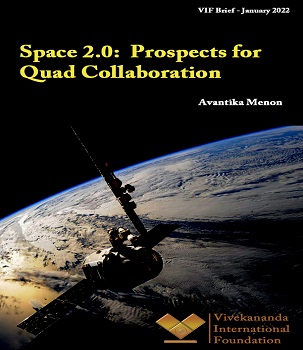


It has been 64 years since the launch of the world’s first artificial satellite, Sputnik 1 that officially marked the dawn of humanity’s ever-growing fascination with exploring the vast reaches of outer space. From launching manned missions, orbiters, exploratory probes to landers and rovers, in the matter of a few decades mankind has made significantly great strides in space exploration. In addition to being an arena for scientific curiosity and exploration, space, particularly the Lower Earth Orbit (LEO) and the Geostationary Earth Orbit (GEO) have emerged as important avenues for the functioning of several new technologies. Essential services and devices such as Global Positioning System (GPS), televisions, phones, online payment and broadband services are all embedded in infrastructure that is dependent on satellites for their functioning.
Links:
[1] https://www.vifindia.org/brief/2022/january/18/Space-2-0-Prospects-for-Quad-Collaboration
[2] https://www.vifindia.org/sites/default/files/Space-2-0-Prospects-for-Quad-Collaboration.pdf
[3] http://www.facebook.com/sharer.php?title=Space 2.0: Prospects for Quad Collaboration&desc=&images=https://www.vifindia.org/sites/default/files/Space-2-0-Prospects-for-Quad-Collaboration.pdf&u=https://www.vifindia.org/brief/2022/january/18/Space-2-0-Prospects-for-Quad-Collaboration
[4] http://twitter.com/share?text=Space 2.0: Prospects for Quad Collaboration&url=https://www.vifindia.org/brief/2022/january/18/Space-2-0-Prospects-for-Quad-Collaboration&via=Azure Power
[5] whatsapp://send?text=https://www.vifindia.org/brief/2022/january/18/Space-2-0-Prospects-for-Quad-Collaboration
[6] https://www.vifindia.org/author/Avantika-Menon